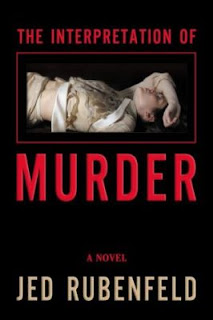The Interpretation of Murder

Summary (from the publisher): In this ingenious, suspenseful historical thriller, Sigmund Freud is drawn into the mind of a sadistic killer who is savagely attacking Manhattan's wealthiest heiresses.
Inspired by Sigmund Freud's only visit to America, The Interpretation of Murder is an intricate tale of murder and the mind's most dangerous mysteries. It unfurls on a sweltering August evening in 1909 as Freud disembarks from the steamship George Washington, accompanied by Carl Jung, his rival and protégé. Across town, in an opulent apartment high above the city, a stunning young woman is found dangling from a chandelier--whipped, mutilated, and strangled. The next day, a second beauty--a rebellious heiress who scorns both high society and her less adventurous parents--barely escapes the killer. Yet Nora Acton, suffering from hysteria, can recall nothing of her attack. Asked to help her, Dr. Stratham Younger, America's most committed Freudian analyst, calls in his idol, the Master himself, to guide him through the challenges of analyzing this high-spirited young woman whose family past has been as complicated as his own. The Interpretation of Murder leads readers from the salons of Gramercy Park, through secret passages, to Chinatown--even far below the currents of the East River where laborers are building the Manhattan Bridge. As Freud fends off a mysterious conspiracy to destroy him, Younger is drawn into an equally thrilling adventure that takes him deep into the subterfuges of the human mind. Richly satisfying, elegantly crafted, The Interpretation of Murder marks the debut of a brilliant, spectacularly entertaining new storyteller.
Review: I was drawn to this novel because of the reference to Freud and the use of psychoanalysis in uncovering the mystery of the murders and attacks. This novel had one of the most intricate plots I've ever encountered. There were a lot of characters, a lot of varying suspects, and a lot of detail. I loved the subtle interweaving of historical detail from factory strikes of 1909 to early forensic and medical practices to factual conversations held between Freud and Jung. I found parts of this novel particularly suspenseful, especially the scene deep under the East River in the caisson. And I loved the description of society and lady's clothing from the early twentieth century that were included when relevant to the plot.
However, at times I feel that Rubenfeld tried to interweave too much historical detail at the expense of focus on the plot of the novel. This book was almost overboard on the intellectual aspects; I especially didn't like the continual references of Dr. Stratham Younger to Hamlet's "To be or not to be" speech as he tries to puzzle over the Oedipus complex and diagnose Nora Acton. I felt that it was a sort of random tangent that just distracted from the interesting murder mystery at hand. Additionally, Freud's role in this novel was over-emphasized in the summary, which was sort of disappointing. Finally, I was distracted by the jump from third person narrative to first person narrative of Dr. Younger. I suppose Dr. Younger was supposed to be the central character, but I didn't really get that sense, mostly because of the complexity of the plot and the large number of characters involved.
Overall, a compelling historical suspense novel. History buffs (particulary those with a knowledge of NYC, medicine, or forensics) and psych majors will certainly appreciate this read.
Stars: 3.5


Comments
Post a Comment